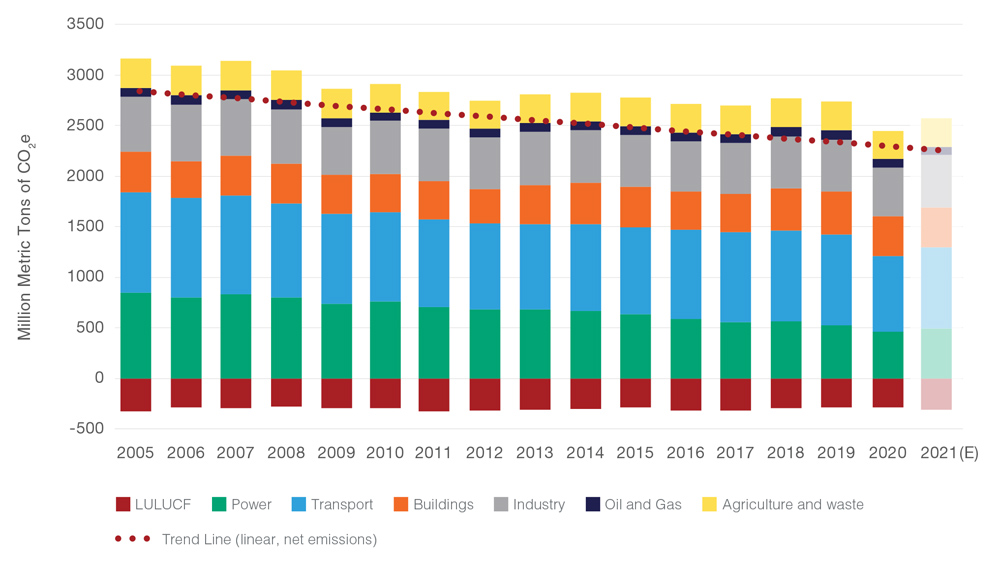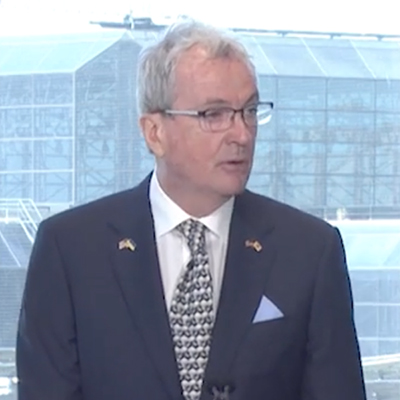
The U.S. Climate Alliance, created in response to former President Donald Trump’s decision to withdraw from the Paris Agreement on climate change, noted its fifth anniversary this week, celebrating its achievements and partnership with the Biden administration while soberly acknowledging the increasing impact of climate-related disasters.
Founded by California, New York and Washington state, the Alliance now numbers 23 states and Puerto Rico, representing 58% of the U.S. gross domestic product, 54% of its population and 41% of net greenhouse gas emissions.
The Alliance’s annual report, released this week, said its members reduced their net GHG emissions by 24% between 2005 and 2020, keeping them on track for meeting the Paris goals: at least a 26% cut in GHG emissions from 2005 levels by 2025, at least a 50% cut by 2030 and net-zero emissions by 2050.
‘Dozens of New Laws’
Alliance members initiated “more than 40 high-impact actions” last year, the report said, including “dozens of new laws to adopt more aggressive emissions-reduction requirements and targets, reduce the climate impact of vehicles and buildings, and create governing bodies to guide state resilience and environmental justice actions and establish priorities. Members also have developed regulations to codify and operationalize their participation in carbon markets, EV sales mandates, and methane reductions from the oil and gas sector.”
 The U.S. Climate Alliance — 23 states and Puerto Rico — reduced their net greenhouse gas emissions by 24% between 2005 and 2020. | U.S. Climate Alliance
The U.S. Climate Alliance — 23 states and Puerto Rico — reduced their net greenhouse gas emissions by 24% between 2005 and 2020. | U.S. Climate Alliance
The report also touted the impacts of the state’s actions:
- Nearly half of the electricity generated in Alliance states is from zero-carbon resources, compared to about one-third in the rest of the country. Non-Alliance states are more than twice as reliant on coal power as Alliance members.
- Alliance members generate half of the levels of criteria pollutants per capita of non-Alliance states, on average.
- As of 2020, utility energy efficiency programs in Alliance states saved 1.5 MWh of electricity per capita over the lifetime of their programs, compared to 0.65 MWh per capita in the rest of the U.S.
- Alliance members employ more than 40% more workers in renewable energy and energy efficiency than non-Alliance states.
The report also cited the growth of electric vehicle sales, with pure EVs accounting for 5.6% of vehicle sales in the second quarter of 2022, more than double the previous year. It also noted that solar and wind power account for nearly two-thirds of electric generation capacity expected to come online in 2022, with battery storage representing another 11%.
Friends in Washington
Created to fill a void in federal policy, the Alliance now has an ally in the White House. It praised the Biden administration for adopting more stringent corporate average fuel economy (CAFE) standards, reinstating California’s authority to implement its own GHG emissions rules for cars and light-duty trucks, and its support for offshore wind. It also celebrated the administration’s recent legislative wins.
“With the passage of the Infrastructure Investment and Jobs Act and Inflation Reduction Act, states now have a major role to play in implementing and delivering the new and expanded programs and funding in a way that maximizes their climate benefits,” it said. The bills are the largest climate investments in U.S. history, with the IRA providing $369 billion in funding for climate and energy programs and $4 billion for Western drought resilience.
But the Alliance also noted U.S. experienced 20 “billion-dollar” extreme weather and climate-related events in 2021 totaling $145 billion, with another in the first half of 2022.
“One in three Americans report that an extreme weather event has personally affected them over the past two years,” it said, citing a Gallup poll. “And, as of June 2022, nearly every region of the continental United States had experienced some form of extreme weather including extreme heat, violent thunderstorms, wildfires, prolonged droughts and flooding.”
It also cited the Supreme Court’s ruling in June limiting EPA’s authority to curb GHG emissions from power plants. (See Supreme Court Rejects EPA Generation Shifting.)
“This moment has hardened the resolve of Alliance governors to continue moving forward with bold state climate action in 2023 and beyond,” it said. “States will continue playing a critical role in achieving the nation’s climate goals by maximizing the climate benefits from new and expanded federal programs, thanks to recent congressional action, while continuing to advance bold climate action beyond the federal floor.”
Climate Week Announcements
The Alliance released its report during Climate Week in New York City, where New York Gov. Kathy Hochul and New Jersey Gov. Phil Murphy gave a joint press conference Wednesday. The governors spoke in front of more than 1,400 solar panels recently installed on the roof of the Javits Convention Center, the largest rooftop solar farm in Manhattan.
Hochul, one of three co-chairs of the Alliance, used the conference to announce an executive order committing to 100% renewable energy in state operations by 2030. All light-duty nonemergency vehicle fleets will be zero-emission vehicles by 2035, and all medium- and heavy-duty vehicle fleets will be ZEVs by 2040. She also said state agencies and authorities, which hold $50 billion in investments, will reach net zero in their portfolios by 2040.
 New Jersey Gov. Phil Murphy | Gov. Kathy Hochul
New Jersey Gov. Phil Murphy | Gov. Kathy Hochul“I’m not going to tell the private sector what to do if we’re not prepared to make those same decisions internally,” she said. “We are going to transition to 100% renewable energy in all state operations by the year 2030. I’m making that pivot right now. We’re going to get that done.”
She also announced the state’s sixth competitive renewable energy solicitation, calling for 2,000 MW in large-scale projects.
And she made a pitch for her proposed $4.2 billion environmental bond issuance, which will be subject to a referendum in November, saying it would be “a game-changing investment in our infrastructure for our clean energy future.”
A major component of several Alliance members’ decarbonization strategies is offshore wind, with East Coast governors committing to almost 40 GW in procurements. That total increased with Murphy’s announcement Wednesday that he was boosting New Jersey’s target from 7,500 MW by 2035 to 11,000 by 2040.
“This is an aggressive target, but an achievable one when we combine the offshore wind plan currently in place and moving forward [and] the opportunities of the recently auctioned portions [of] the New York Bight, and the technological advancements that are making turbines more and more efficient, almost literally by the day,” Murphy said.
New York’s current OSW target is 9,000 MW by 2035.
While both states hope their OSW investments will produce economic development, Murphy insisted they were not in competition.
“I like to think of this as a cross-country meet. It’s not about the individual times; it’s about the team score. And while we’re still running for personal bests … we don’t win unless we each pull each other along so that the team wins,” he said.
Elections Loom
The Alliance expressed confidence that its progress will continue after the November elections, saying it was “committed to working across party lines with all governors willing to advance tangible climate solutions.”
Hochul is one of 36 governors who will face voters this fall, including 18 of the 23 states in the alliance. Twenty of the seats are currently held by Republicans and 16 by Democrats. (Murphy was narrowly re-elected last year.)
The Cook Political Report projects eight races, including New York, as solid Democratic and six leaning or likely Democrat, all of them members of the Alliance. Two of those states are currently headed by Republican moderates: Maryland’s Larry Hogan, who is term limited, and Massachusetts’ Charlie Baker, who is not seeking re-election.
Cook projects 12 solid Republican and five leaning/likely for the GOP, with only one — Vermont — a member of the Alliance.
That leaves five “toss up” races, including Alliance states Nevada, Oregon and Wisconsin and non-members Arizona and Kansas.



